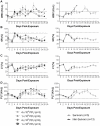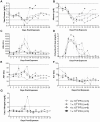Experimental infection of cynomolgus macaques (Macaca fascicularis) with aerosolized monkeypox virus
- PMID: 20862223
- PMCID: PMC2942837
- DOI: 10.1371/journal.pone.0012880
Experimental infection of cynomolgus macaques (Macaca fascicularis) with aerosolized monkeypox virus
Abstract
Monkeypox virus (MPXV) infection in humans results in clinical symptoms very similar to ordinary smallpox. Aerosol is a route of secondary transmission for monkeypox, and a primary route of smallpox transmission in humans. Therefore, an animal model for aerosol exposure to MPXV is needed to test medical countermeasures. To characterize the pathogenesis in cynomolgus macaques (Macaca fascicularis), groups of macaques were exposed to four different doses of aerosolized MPXV. Blood was collected the day before, and every other day after exposure and assessed for complete blood count (CBC), clinical chemistry analysis, and quantitative PCR. Macaques showed mild anorexia, depression, and fever on day 6 post-exposure. Lymphadenopathy, which differentiates monkeypox from smallpox, was observed in exposed macaques around day 6 post-exposure. CBC and clinical chemistries showed abnormalities similar to human monkeypox cases. Whole blood and throat swab viral loads peaked around day 10, and in survivors, gradually decreased until day 28 post-exposure. Survival was not dose dependent. As such, doses of 4 × 10(4) PFU, 1 × 10(5) PFU, or 1 × 10(6) PFU resulted in lethality for 70% of the animals, whereas a dose of 4 × 10(5) PFU resulted in 85% lethality. Overall, cynomolgus macaques exposed to aerosolized MPXV develop a clinical disease that resembles that of human monkeypox. These findings provide a strong foundation for the use of aerosolized MPXV exposure of cynomolgus macaques as an animal model to test medical countermeasures against orthopoxviruses.
Conflict of interest statement
Figures






References
-
- Parker S, Nuara A, Buller RM, Schultz DA. Human monkeypox: an emerging zoonotic disease. Future Microbiol. 2007;2:17–34. - PubMed
-
- Nalca A, Rimoin AW, Bavari S, Whitehouse CA. Reemergence of monkeypox: prevalence, diagnostics, and countermeasures. Clin Infect Dis. 2005;41:1765–1771. - PubMed
-
- Jezek Z, Fenner F. Basel; New York: Karger; 1988. Human monkeypox.
-
- Fine PE, Jezek Z, Grab B, Dixon H. The transmission potential of monkeypox virus in human populations. Int J Epidemiol. 1988;17:643–650. - PubMed
MeSH terms
Substances
LinkOut - more resources
Full Text Sources
Medical
Research Materials

